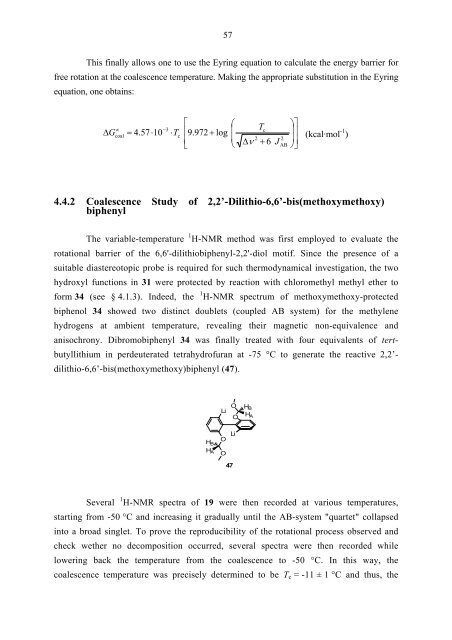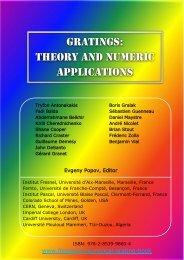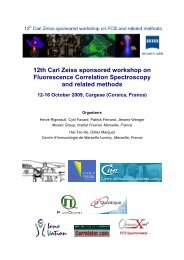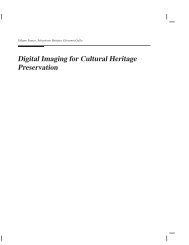My PhD dissertation - Institut Fresnel
My PhD dissertation - Institut Fresnel
My PhD dissertation - Institut Fresnel
You also want an ePaper? Increase the reach of your titles
YUMPU automatically turns print PDFs into web optimized ePapers that Google loves.
57<br />
This finally allows one to use the Eyring equation to calculate the energy barrier for<br />
free rotation at the coalescence temperature. Making the appropriate substitution in the Eyring<br />
equation, one obtains:<br />
∆G<br />
≠<br />
coal<br />
=<br />
4.<br />
57⋅10<br />
−3<br />
⎡ ⎛<br />
⎢ ⎜ Tc<br />
⋅Tc<br />
9.<br />
972 + log<br />
⎢ ⎜ 2<br />
⎣ ⎝ ∆ν<br />
+ 6 J<br />
2<br />
AB<br />
⎞⎤<br />
⎟⎥<br />
⎟<br />
⎠<br />
⎥<br />
⎦<br />
(kcal·mol -1 )<br />
4.4.2 Coalescence Study of 2,2’-Dilithio-6,6’-bis(methoxymethoxy)<br />
biphenyl<br />
The variable-temperature 1 H-NMR method was first employed to evaluate the<br />
rotational barrier of the 6,6'-dilithiobiphenyl-2,2'-diol motif. Since the presence of a<br />
suitable diastereotopic probe is required for such thermodynamical investigation, the two<br />
hydroxyl functions in 31 were protected by reaction with chloromethyl methyl ether to<br />
form 34 (see § 4.1.3). Indeed, the 1 H-NMR spectrum of methoxymethoxy-protected<br />
biphenol 34 showed two distinct doublets (coupled AB system) for the methylene<br />
hydrogens at ambient temperature, revealing their magnetic non-equivalence and<br />
anisochrony. Dibromobiphenyl 34 was finally treated with four equivalents of tert-<br />
butyllithium in perdeuterated tetrahydrofuran at -75 °C to generate the reactive 2,2’-<br />
dilithio-6,6’-bis(methoxymethoxy)biphenyl (47).<br />
HB HA Li<br />
O<br />
O<br />
Li<br />
47<br />
O<br />
O<br />
Several 1 H-NMR spectra of 19 were then recorded at various temperatures,<br />
starting from -50 °C and increasing it gradually until the AB-system "quartet" collapsed<br />
into a broad singlet. To prove the reproducibility of the rotational process observed and<br />
check wether no decomposition occurred, several spectra were then recorded while<br />
lowering back the temperature from the coalescence to -50 °C. In this way, the<br />
coalescence temperature was precisely determined to be Tc = -11 ± 1 °C and thus, the<br />
HB HA













